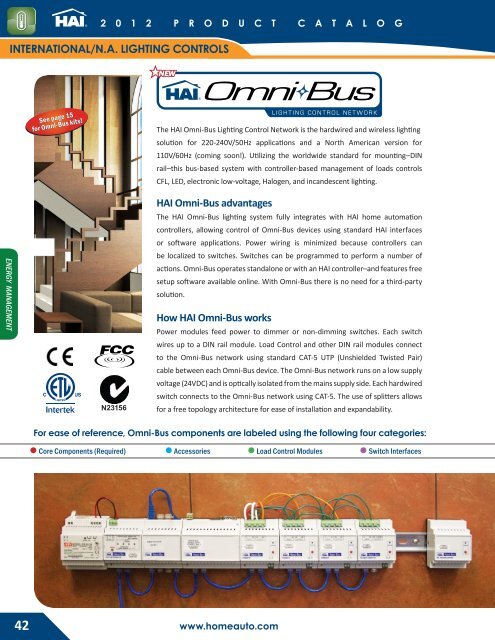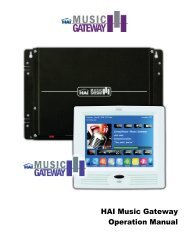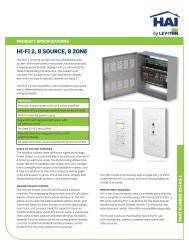Download PDF - Home Automation, Inc
Download PDF - Home Automation, Inc
Download PDF - Home Automation, Inc
Create successful ePaper yourself
Turn your PDF publications into a flip-book with our unique Google optimized e-Paper software.
ENERGY MANAGEMENT<br />
2 0 1 2 P R O D U C T C A T A L O G<br />
INTERNATIONAL/N.A. LIGHTING CONTROLS<br />
See See page page 15<br />
for Omni-Bus Omni-Bus kits! kits!<br />
N23156<br />
NEW<br />
42 www.homeauto.com<br />
The HAI Omni-Bus Lighting Control Network is the hardwired and wireless lighting<br />
solution for 220-240V/50Hz applications and a North American version for<br />
110V/60Hz (coming soon!). Utilizing the worldwide standard for mounting–DIN<br />
rail–this bus-based system with controller-based management of loads controls<br />
CFL, LED, electronic low-voltage, Halogen, and incandescent lighting.<br />
HAI Omni-Bus advantages<br />
The HAI Omni-Bus lighting system fully integrates with HAI home automation<br />
controllers, allowing control of Omni-Bus devices using standard HAI interfaces<br />
or software applications. Power wiring is minimized because controllers can<br />
be localized to switches. Switches can be programmed to perform a number of<br />
actions. Omni-Bus operates standalone or with an HAI controller–and features free<br />
setup software available online. With Omni-Bus there is no need for a third-party<br />
solution.<br />
How HAI Omni-Bus works<br />
Power modules feed power to dimmer or non-dimming switches. Each switch<br />
wires up to a DIN rail module. Load Control and other DIN rail modules connect<br />
to the Omni-Bus network using standard CAT-5 UTP (Unshielded Twisted Pair)<br />
cable between each Omni-Bus device. The Omni-Bus network runs on a low supply<br />
voltage (24VDC) and is optically isolated from the mains supply side. Each hardwired<br />
switch connects to the Omni-Bus network using CAT-5. The use of splitters allows<br />
for a free topology architecture for ease of installation and expandability.<br />
For ease of reference, Omni-Bus components are labeled using the following four categories:<br />
Core Components (Required) Accessories Load Control Modules Switch Interfaces












